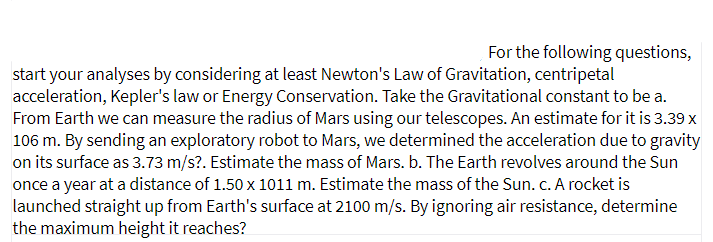For the following questions, start your analyses by considering at least Newton's Law of Gravitation, centripetal acceleration, Kepler's law or Energy Conservation. Take the Gravitational constant to be a. From Earth we can measure the radius of Mars using our telescopes. An estimate for it is 3.39 x 106 m. By sending an exploratory robot to Mars, we determined the acceleration due to gravity on its surface as 3.73 m/s?. Estimate the mass of Mars. b. The Earth revolves around the Sun once a year at a distance of 1.50 x 1011 m. Estimate the mass of the Sun. c. A rocket is launched straight up from Earth's surface at 2100 m/s. By ignoring air resistance, determine the maximum height it reaches?
For the following questions, start your analyses by considering at least Newton's Law of Gravitation, centripetal acceleration, Kepler's law or Energy Conservation. Take the Gravitational constant to be a. From Earth we can measure the radius of Mars using our telescopes. An estimate for it is 3.39 x 106 m. By sending an exploratory robot to Mars, we determined the acceleration due to gravity on its surface as 3.73 m/s?. Estimate the mass of Mars. b. The Earth revolves around the Sun once a year at a distance of 1.50 x 1011 m. Estimate the mass of the Sun. c. A rocket is launched straight up from Earth's surface at 2100 m/s. By ignoring air resistance, determine the maximum height it reaches?
University Physics Volume 1
18th Edition
ISBN:9781938168277
Author:William Moebs, Samuel J. Ling, Jeff Sanny
Publisher:William Moebs, Samuel J. Ling, Jeff Sanny
Chapter13: Gravitation
Section: Chapter Questions
Problem 13.10CYU: Check Your Understanding Earth exerts a tidal force on the Moon. Is it greater than, the same as, or...
Related questions
Question

Transcribed Image Text:For the following questions,
start your analyses by considering at least Newton's Law of Gravitation, centripetal
acceleration, Kepler's law or Energy Conservation. Take the Gravitational constant to be a.
From Earth we can measure the radius of Mars using our telescopes. An estimate for it is 3.39 x
106 m. By sending an exploratory robot to Mars, we determined the acceleration due to gravity
on its surface as 3.73 m/s?. Estimate the mass of Mars. b. The Earth revolves around the Sun
once a year at a distance of 1.50 x 1011 m. Estimate the mass of the Sun. c. A rocket is
launched straight up from Earth's surface at 2100 m/s. By ignoring air resistance, determine
the maximum height it reaches?
Expert Solution
This question has been solved!
Explore an expertly crafted, step-by-step solution for a thorough understanding of key concepts.
This is a popular solution!
Trending now
This is a popular solution!
Step by step
Solved in 3 steps with 4 images

Recommended textbooks for you

University Physics Volume 1
Physics
ISBN:
9781938168277
Author:
William Moebs, Samuel J. Ling, Jeff Sanny
Publisher:
OpenStax - Rice University

Physics for Scientists and Engineers: Foundations…
Physics
ISBN:
9781133939146
Author:
Katz, Debora M.
Publisher:
Cengage Learning

Classical Dynamics of Particles and Systems
Physics
ISBN:
9780534408961
Author:
Stephen T. Thornton, Jerry B. Marion
Publisher:
Cengage Learning

University Physics Volume 1
Physics
ISBN:
9781938168277
Author:
William Moebs, Samuel J. Ling, Jeff Sanny
Publisher:
OpenStax - Rice University

Physics for Scientists and Engineers: Foundations…
Physics
ISBN:
9781133939146
Author:
Katz, Debora M.
Publisher:
Cengage Learning

Classical Dynamics of Particles and Systems
Physics
ISBN:
9780534408961
Author:
Stephen T. Thornton, Jerry B. Marion
Publisher:
Cengage Learning

Glencoe Physics: Principles and Problems, Student…
Physics
ISBN:
9780078807213
Author:
Paul W. Zitzewitz
Publisher:
Glencoe/McGraw-Hill

Stars and Galaxies
Physics
ISBN:
9781305120785
Author:
Michael A. Seeds, Dana Backman
Publisher:
Cengage Learning
